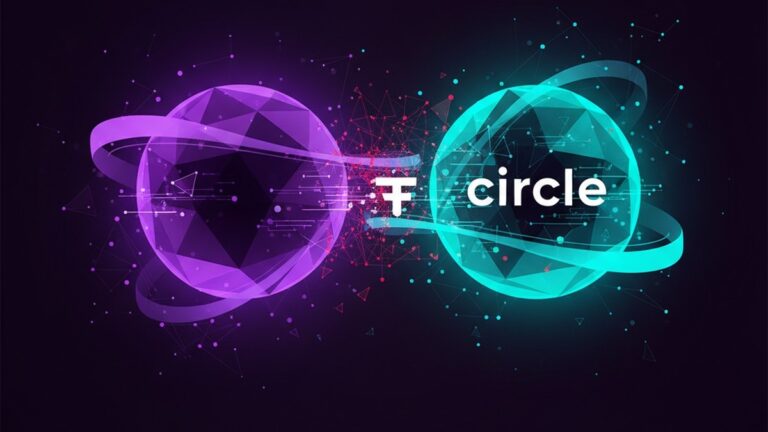As the cryptocurrency landscape continues to evolve, stablecoin behemoths Tether and Circle find themselves under the spotlight for their business practices in a high-interest rate environment. Speaking at Mercado Bitcoin’s DAC 2025 event, Dan Reecer, co-founder of Wormhole, highlighted how these companies are profiting from the yield generated by U.S. Treasuries backing their tokens, a practice he equates to “printing money.” Meanwhile, stablecoin holders see none of these returns, sparking discussions about the future of stablecoins and their role in the broader financial ecosystem.
Tether and Circle’s Lucrative Strategy
The conversation centers around the substantial profits Tether and Circle have amassed thanks to elevated interest rates. Tether, for instance, reported a staggering $4.9 billion net profit in the second quarter, catapulting its valuation to a reported $500 billion in a new funding round. These profits arise because the companies retain the yield from the U.S. Treasuries that back their stablecoins, rather than distributing it to token holders.
Reecer suggests that as interest rates remain high, it’s only a matter of time before users demand a share of this yield or consider moving their funds to alternative platforms. Highlighting the potential for change, he points to new players like M^0 and Agora, which are designing stablecoin infrastructures that redirect yield to either applications or directly to end users. This emerging trend could reshape how stablecoins function and who benefits from their backing assets.
The Regulatory Dilemma
One key reason Tether and Circle may not share yields with users is the potential backlash from regulators. Distributing investment returns could transform the nature of these digital currencies, turning them into investment products rather than stable digital currencies. Tether’s spokesperson emphasized that USDT is meant to be a “digital dollar,” not an investment vehicle, underscoring its critical role in places with high inflation and unstable banking systems.
The spokesperson explained, “While a few percentage points might make a difference for wealthy individuals in the U.S. or Europe, for many in developing countries, the real savings lie in using USDT as a hedge against dramatic inflation.” This perspective highlights the different needs and priorities of stablecoin users across the globe.
Emerging Alternatives and Innovations
Despite the current status quo, alternative options are gaining traction. Money market funds, such as those offered by Circle through its recent $1.3 billion acquisition of Hashnote, are beginning to offer investors exposure to yields generated by the assets backing stablecoins. Though these funds are still a small fraction of the overall stablecoin market, with a market cap of around $7.3 billion compared to the global stablecoin market’s $290 billion, they represent a growing sector.
These tokenized money market funds could bridge the gap for users seeking yield without altering the fundamental nature of stablecoins. Moreover, as Stephen Richardson from Fireblocks pointed out during the panel, the stablecoin market is increasingly being leveraged for real-world applications, such as cross-border payments and foreign exchange services. Tokenized money moving instantly might resolve existing issues like sluggish corporate payment systems and costly remittances.
A Shifting Market Landscape
The current dynamic within the stablecoin market highlights a broader shift towards financial innovation. As platforms like M^0 and Agora explore new ways to distribute yields and money market funds gain popularity, the market could be poised for significant transformation. These developments suggest a future where stablecoins serve not only as digital representations of fiat currency but also as vehicles for yield generation and financial inclusivity.
While Tether and Circle remain leaders in the stablecoin arena, the competition is undeniably brewing. As users become more knowledgeable and demanding, these giants may need to adapt their strategies to retain their user base. Whether through regulatory changes, technological advancements, or market-driven innovations, the stablecoin market appears to be on the brink of a new era.
In this evolving landscape, the conversation around stablecoins is no longer just about their stability or utility. It is increasingly about who benefits from the underlying financial dynamics and how these digital currencies can be tailored to meet the diverse needs of a global user base. As the market continues to grow and diversify, the dialogue around stablecoins will likely shift from mere stability to broader financial empowerment and innovation.

Steve Gregory is a lawyer in the United States who specializes in licensing for cryptocurrency companies and products. Steve began his career as an attorney in 2015 but made the switch to working in cryptocurrency full time shortly after joining the original team at Gemini Trust Company, an early cryptocurrency exchange based in New York City. Steve then joined CEX.io and was able to launch their regulated US-based cryptocurrency. Steve then went on to become the CEO at currency.com when he ran for four years and was able to lead currency.com to being fully acquired in 2025.


